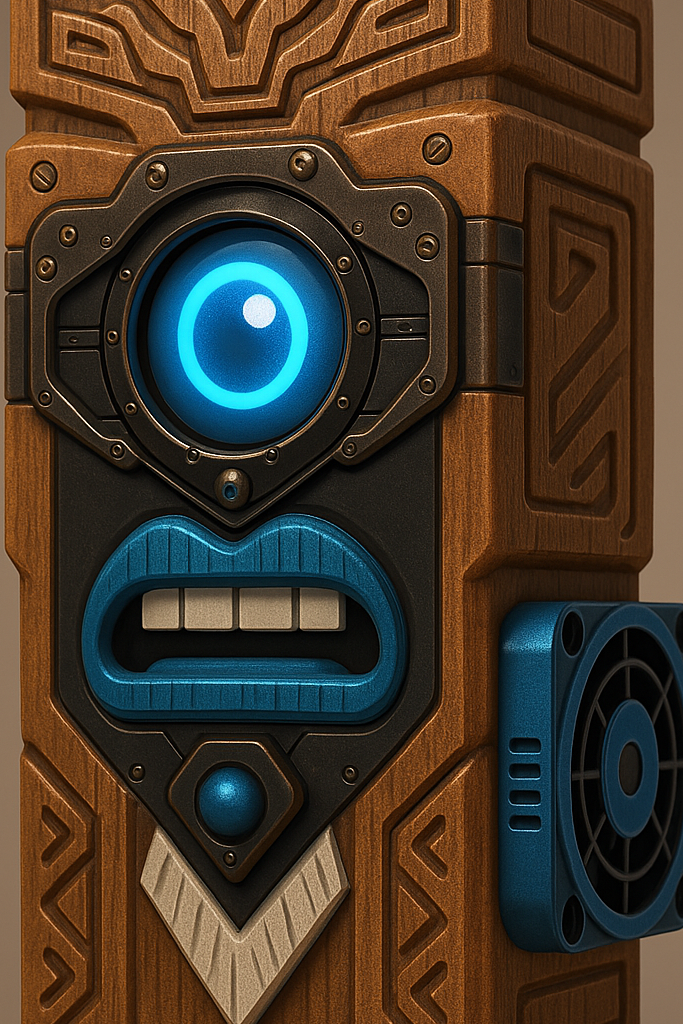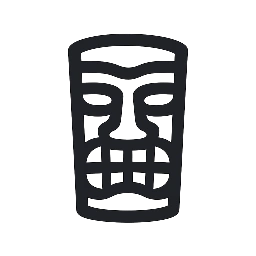PLA’ka-Tiki
vs.
G-codehuahua
A tale of fire, failure, and the divine war behind every print
In the quiet hum of every print bed, in the whisper of fans and the smell of melted plastic, there exists a war far older than your slicer settings. It’s the eternal struggle between PLA’ka-Tiki and G-codehuahua — two divine forces shaping the outcome of your every creative effort.
These aren’t just characters.
They’re mindsets made myth.
And their names hold the truth of making itself.
Who is PLA’ka-Tiki?

PLA’ka-Tiki is a mythical island god born from fire, patience, and craftsmanship. He is the spirit of creation, precision, and sharing — the guardian of projects that take time, care, and attention to detail. He represents everything good about the act of making: not just building things, but doing it right, learning as you go, and passing that knowledge on.
He’s calm but powerful. Generous but focused.
He’s what happens when a tiki god teaches you to build something, then hands you the tool with a wink and says,
“Now make it better.”
Name Meaning: “PLA’ka-Tiki”
His name is a layered pun, rich with meaning both modern and mythic.
- PLA (Polylactic Acid) is one of the most common materials in 3D printing. Biodegradable and plant-based, it’s smooth, forgiving, and beloved by beginners and experts alike — the “good guy” of materials.
- “Ka-Tiki” evokes the name structure of Polynesian island deities — gods tied to fire, nature, artistry, and sacred ritual. Tikis are traditionally carved figures representing ancestral spirits or elemental forces of protection, fertility, and craftsmanship.
So “PLA’ka-Tiki” sounds like an ancient volcano spirit carved from lava and wood — and that’s exactly what he is. But he’s also literally the god of beginner-friendly filament, guiding the maker’s hand from first layer to final polish.
He embodies:
- Patience
- Smooth layers
- Joy in sharing
He is the divine embodiment of things going right — the god of the successful print, the clean Benchy, the perfectly bridging test cube. He lives in every print that finished because you took the time to do it well.
Who is G-codehuahua?
G-codehuahua is PLA’ka-Tiki’s corrupted counterpart — a digital gremlin of chaos, sabotage, and printer-based spite. He isn’t evil in the grand, dramatic sense. He’s worse: petty, vindictive, and glitchy on purpose. He whispers doubt. He causes mistakes that feel like your fault. He delights in watching beautiful things fall apart just before they’re done.

He’s the voice in your head that says:
“It’s not worth fixing. Just trash it.”
Name Meaning: “G-codehuahua”
His name is also a pun — one of coded mischief and mechanical failure.
- G-code is the raw command language that tells 3D printers what to do — where to move, how fast, how hot, how much to extrude. It is the sacred scroll of the machine — precise and vital, but frighteningly fragile. A single typo can ruin everything.
- “Chihuahua” brings to mind a small, unhinged force of erratic energy — twitchy, high-strung, unpredictable, yapping at things that don’t exist. Add that energy to broken machine code, and you have the embodiment of software-based mischief.
So “G-codehuahua” becomes the manifestation of bad G-code — the spirit of the spaghetti-print, the phantom layer shift, the nightmare raft.
He lives in:
- Unexplained failures
- Warped corners
- That one cursed setting you forgot to change
He’s not a mighty demon. He’s worse — a nuisance that thrives on your frustration.
He feeds on:
- Rushed jobs
- Lazily sliced files
- The moment you click “print” and think “Eh, it’ll probably be fine…”
He doesn’t destroy your print. He lets you do it… and then laughs.
Their Conflict
Their battle isn’t just between two beings — it’s a clash between two mentalities.
- One says: “Take your time. Share the journey.”
- The other hisses: “Break it. Hide your mistakes. Quit.”
Every time you attempt to make something — whether it’s a print, a painting, a story, a plan — you are caught between them.
One hands you a gift.
The other hides the manual.
And the choice — is always yours.
Why Their Names Matter
These aren’t just clever wordplays — they’re symbols for the opposing forces within every creative process.
- PLA’ka-Tiki is the maker’s ideal: clean, methodical, generous. The spirit that says, “You can fix this. Let’s try again.” He’s the god you call on when you want to tune your settings, calibrate your flow rate, or help a stranger fix their first Benchy.
- G-codehuahua is the saboteur: the creeping voice that says, “It’s broken anyway. Just run it.” He’s the part of you that wants to rage-quit and yeet the whole printer out the window.
Their names teach you the language of making — the emotional and technical terrain of creation:
- That mistakes are sacred.
- That trying again is part of the process.
- That success isn’t a moment — it’s a mindset.
So next time the bed’s not level, or your model warps at the corners… ask yourself:
Who’s whispering to you?
And who do you want to listen to?
The gods are real.
The war is constant.
The filament is hot.
Choose wisely.
